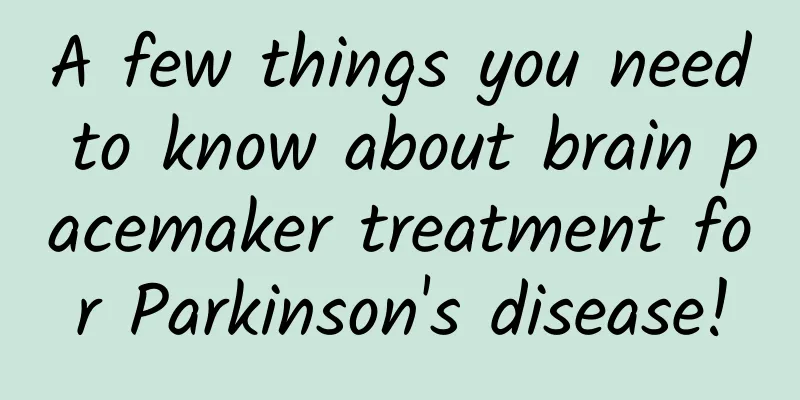A few things you need to know about brain pacemaker treatment for Parkinson's disease!

|
Author: Zhang Jianguo, Chief Physician, Beijing Tiantan Hospital, Capital Medical University Chairman of the Functional Neurosurgery Group of the Neurosurgery Branch of the Chinese Medical Association Reviewer: Dong Jian, Chief Physician, Zhongshan Hospital, Fudan University Vice Chairman of the Science Popularization Branch of the Chinese Medical Association A brain pacemaker is an implantable medical device that implants electrodes into the brain and uses discharges to treat diseases. At present, brain pacemakers can treat many diseases, such as the common Parkinson's disease, essential tremor, dystonia, epilepsy, obsessive-compulsive disorder, etc. For Parkinson's patients, there are several issues that patients are very concerned about. Let's take a look at them together. 1. What are the advantages of brain pacemakers in treating Parkinson’s disease? Brain pacemakers have several obvious advantages: First, minimally invasive. Brain pacemaker surgery does not require craniotomy. Instead, only two holes need to be drilled, and very thin electrodes are implanted into the brain with the assistance of a stereotactic device or a robot. Then, the wires and stimulator are connected and buried under the skin of the head, neck, and chest, so the damage is minimal. Second, the efficacy is good. After Parkinson's patients are treated with brain pacemakers, they can generally achieve the best state of medication and remain relatively stable, even better than medication. Third, it is reversible. What is reversible? It means that the electrical stimulation can be adjusted or turned off, or even removed, without causing obvious harm to the patient. Fourth, it can be regulated. The so-called regulation is to adjust it through an external programmable device. Parkinson's disease itself is constantly progressing. If the patient's symptoms are getting worse, the parameters can be adjusted to achieve a better improvement of the symptoms. Fifth, when Parkinson's disease patients have symptoms on both sides, they can also be treated with brain pacemakers. For Parkinson's disease patients with obviously asymmetric motor symptoms, it should be considered to implant bilateral brain pacemakers at the same time, which can achieve better treatment effects. Figure 1 Original copyright image, no permission to reprint So these are the five main advantages of brain pacemakers. 2. Which symptoms of Parkinson's disease are best treated with brain pacemakers? There are four main symptoms of Parkinson's disease. It includes tremor, mainly resting tremor and hand tremor; stiffness, which is what we call muscle rigidity, for example, the patient's whole body is in a flexed state, the trunk is flexed, and the neck is also flexed; another is slow movement, such as turning over slowly and walking slowly; and another is postural balance disorder, such as easily falling while walking. If these symptoms respond to medication, the brain pacemaker will also have a better effect on these symptoms. Of course, compared to the good results, there may be some symptoms that are not well treated, such as cognitive dysfunction, swallowing dysfunction, low voice, unfluent speech, etc. in the late stage of Parkinson's disease. The brain pacemaker may not be very effective in treating these symptoms. 3. What examinations are needed before brain pacemaker surgery to treat Parkinson's disease? Because the diagnosis of patients does not require a lot of tests, it relies more on the doctor's experience, that is, to evaluate the patient by observing symptoms and response to drugs. The so-called evaluation is to ask the patient to do various actions while taking the medicine and score the actions. Also give a score when not taking the medicine. The two scores are compared to see how much improvement there is. Through this score, the doctor can be more confident about the treatment situation. As for preoperative examinations, these are some examinations that must be done before the operation, such as blood routine, electrocardiogram, chest X-ray, etc. In addition, an MRI scan is performed to check the patient's brain atrophy. At the same time, another function of the MRI scan is to locate the brain nuclei during surgery, that is, to locate the electrode implantation site. 4. Do I still need to take medication after undergoing brain pacemaker surgery to treat Parkinson’s disease? There are two aspects to the treatment of Parkinson's disease: one is drug treatment and the other is surgical treatment. In the early stages of the disease, it can be completely treated with drugs, but when the patient's condition progresses and drug side effects occur, surgery must be performed. Of course, surgical intervention cannot completely cure the disease, so surgery needs to be combined with drugs to achieve a stable therapeutic effect. Figure 2 Original copyright image, no permission to reprint Some patients trembled badly before surgery, but after surgery, they stopped trembling completely, so they stopped taking the medicine. But after a while, they complained that they had no energy and no strength. This is because they lack dopamine in their bodies. If they do not supplement it with medicine, they will experience corresponding symptoms. We will ask patients to add medicine. Of course, the amount of medication after surgery can be controlled or even reduced. For example, compared with preoperative medication, it can be reduced by about one-quarter to one-half. If the patient takes enough medication before surgery, the amount of medication can indeed be reduced after surgery, but it generally cannot be completely stopped. 5. How many years can brain pacemaker surgery be used to treat Parkinson's disease? Brain pacemakers do have a lifespan. The earliest pacemakers were not rechargeable and had a service life of about 5 years. Of course, we now have rechargeable brain pacemakers that can be charged through an external charging device and have a service life of about 15-20 years. Because although it can be recharged, it also needs to replace the battery every 15-20 years. Of course, replacing the battery is a very small operation, which is to open the incision in the chest, take out the battery, replace it with a new battery, put it in and sew it up. This is a minor outpatient operation that can be completed in about half an hour. |
<<: Cute and dangerous "cute pets"
>>: What are the characteristics of pain caused by stroke? Is there any way to treat it?
Recommend
Endocrine disorders can cause amenorrhea
For the sake of their own health, women must deve...
Every autumn rain brings a chill. How should we deal with the drastic drop in temperature?
Recently, the Central Meteorological Observatory ...
What are some ways to speed up the disappearance of the cervical canal?
Giving birth to a child is a long and complicated...
Is drinking water to lose weight effective? This is the best way to drink
Drinking water to lose weight is one of the many ...
Is it normal to have an accelerated heart rate during pregnancy?
Pregnancy is a stage that every female friend pay...
Why are strawberries so much more expensive than dried strawberries? How are dried strawberries made?
Strawberries are very expensive on the market, bu...
Is it worth a fortune to stay slim in old age? Even if you are thin, you must have muscles and bones!
As the saying goes, "It's worth a fortun...
Is breast swelling a sign of pregnancy?
Breast swelling refers to a situation in which wo...
How to store grapefruit? Is the flesh of grapefruit white or red?
For white grapefruit, its peel is generally golde...
Is low progesterone serious?
I believe everyone knows what progesterone is. Pr...
What is the reason for leucorrhea and yellow snot?
The health of modern women is very worrying. Many...
Can women lose weight by standing for half an hour after a meal?
Losing weight is something that many girls will d...
9 health traps that women are most likely to believe
Young female white-collar workers have now become...
Daily Interaction: 5G Smartphone Report for the First Quarter of 2024
The 5G smartphone market continues to heat up. Ac...
How to regulate scanty menstruation with Chinese medicine
Because each woman's physical constitution is...









